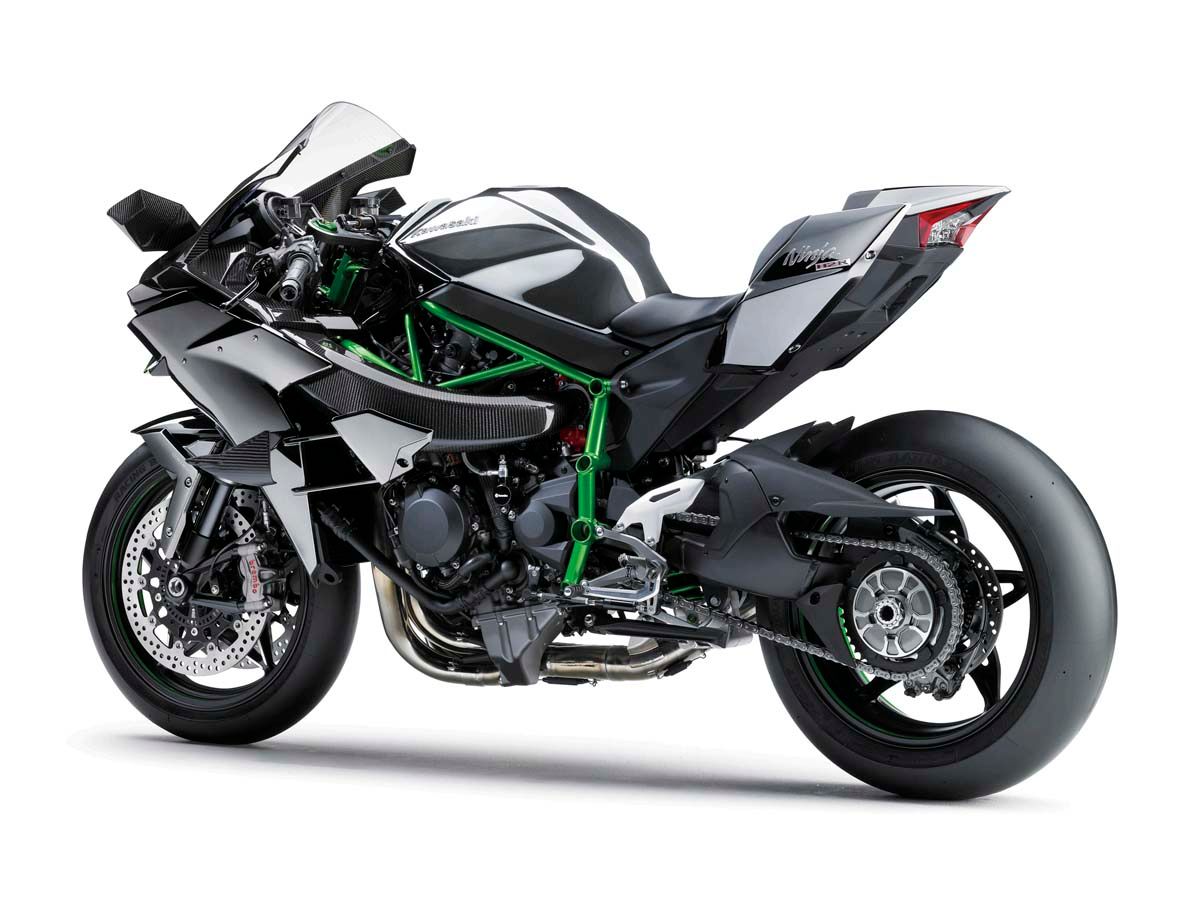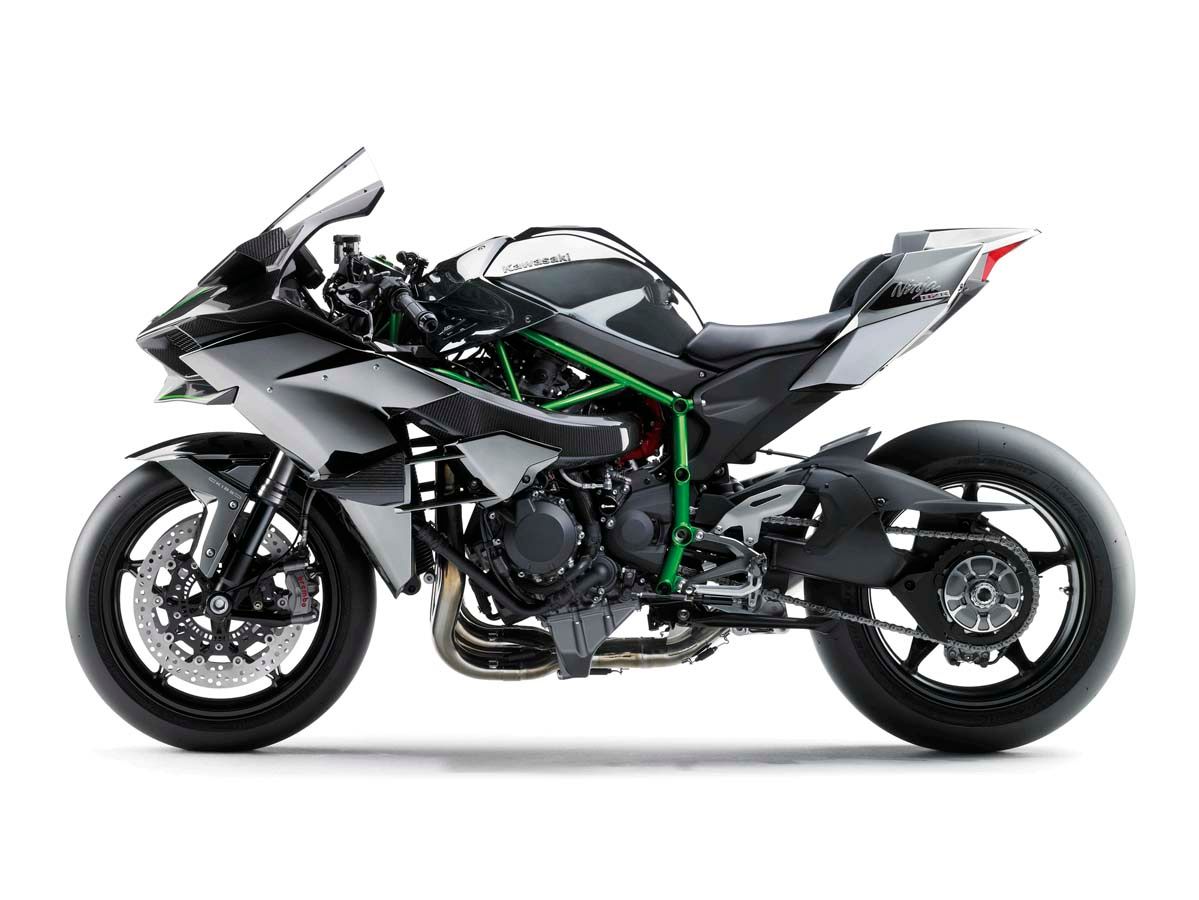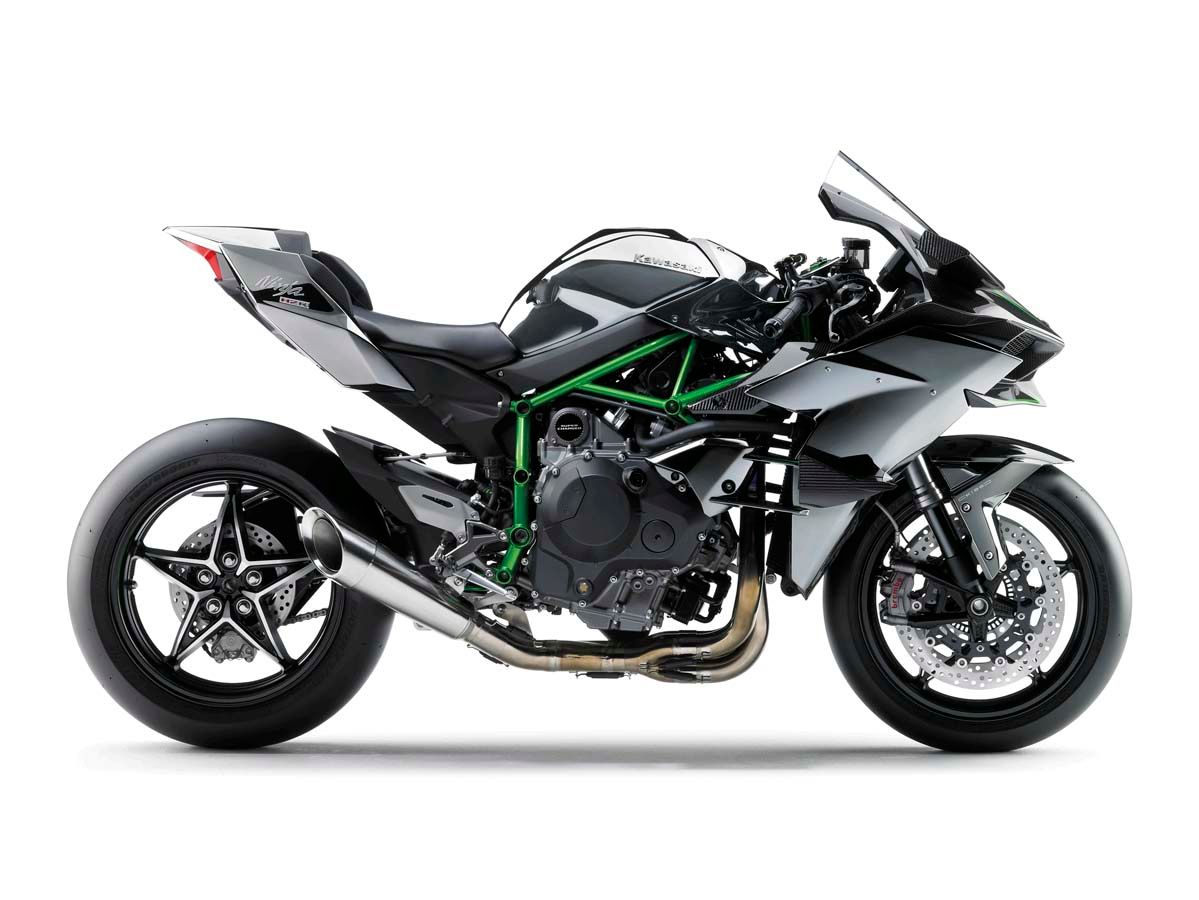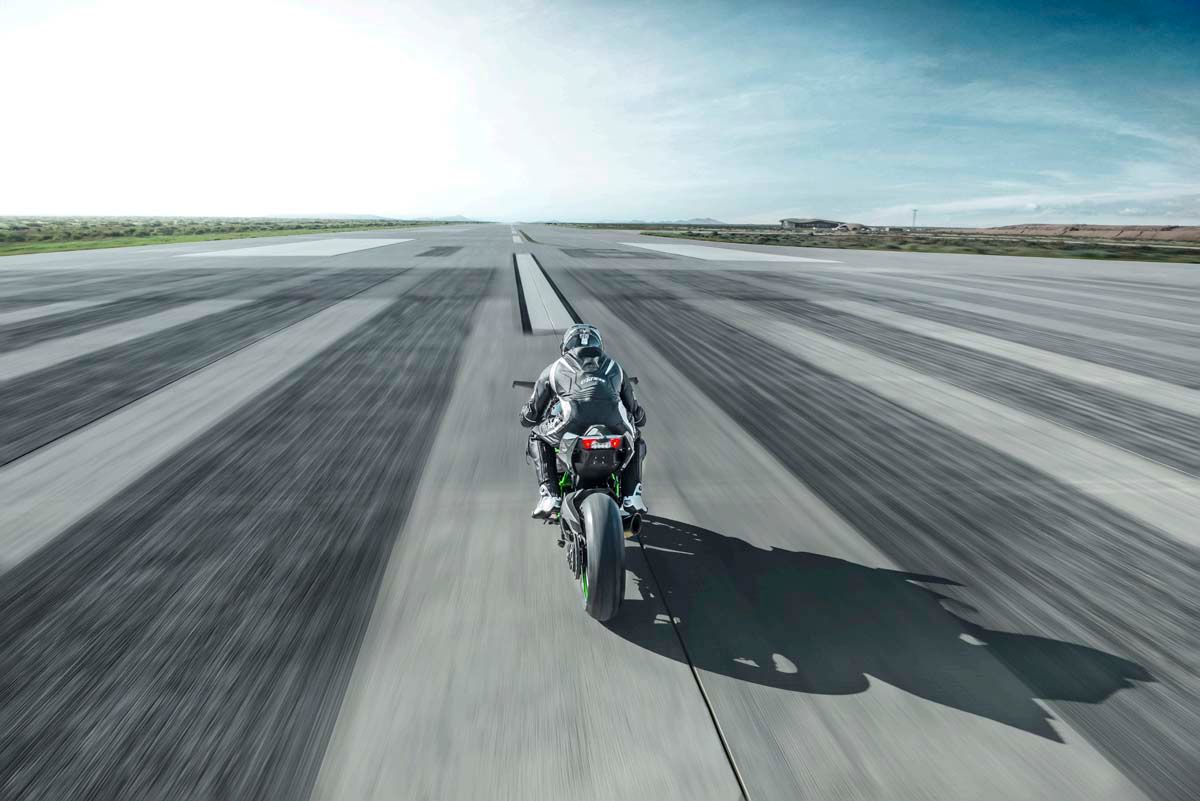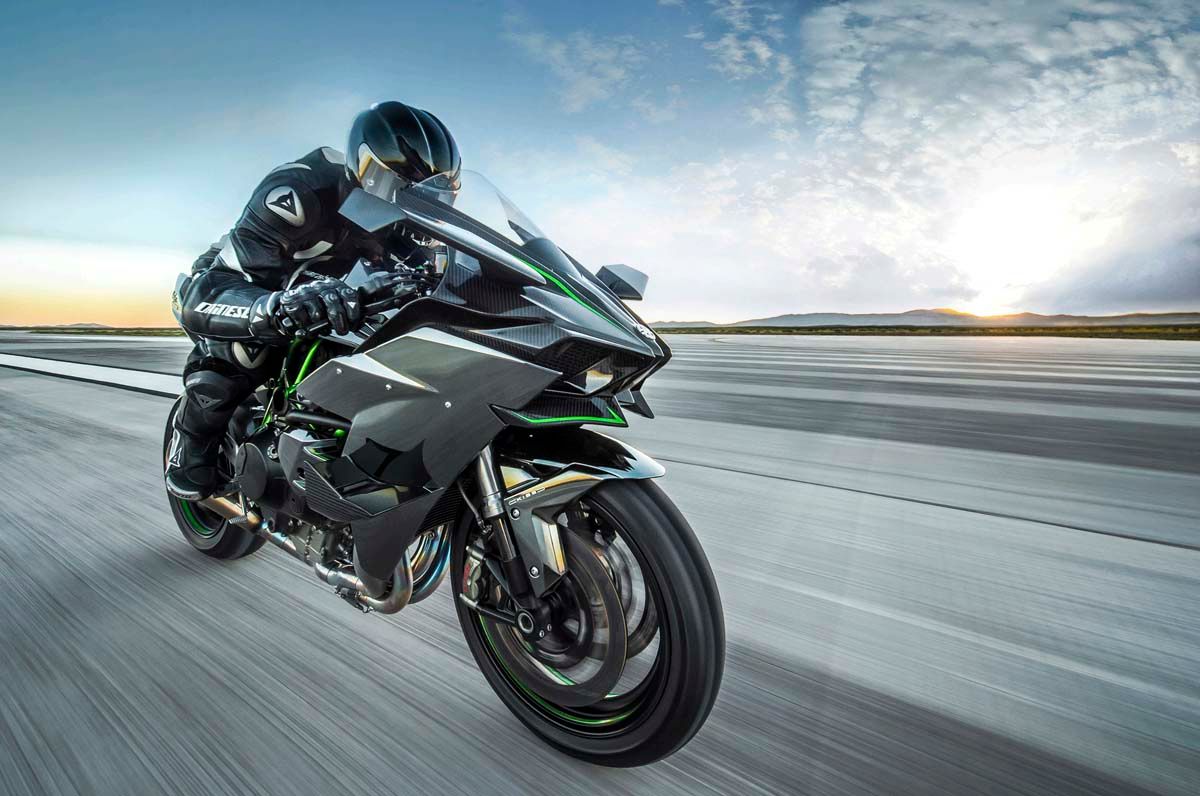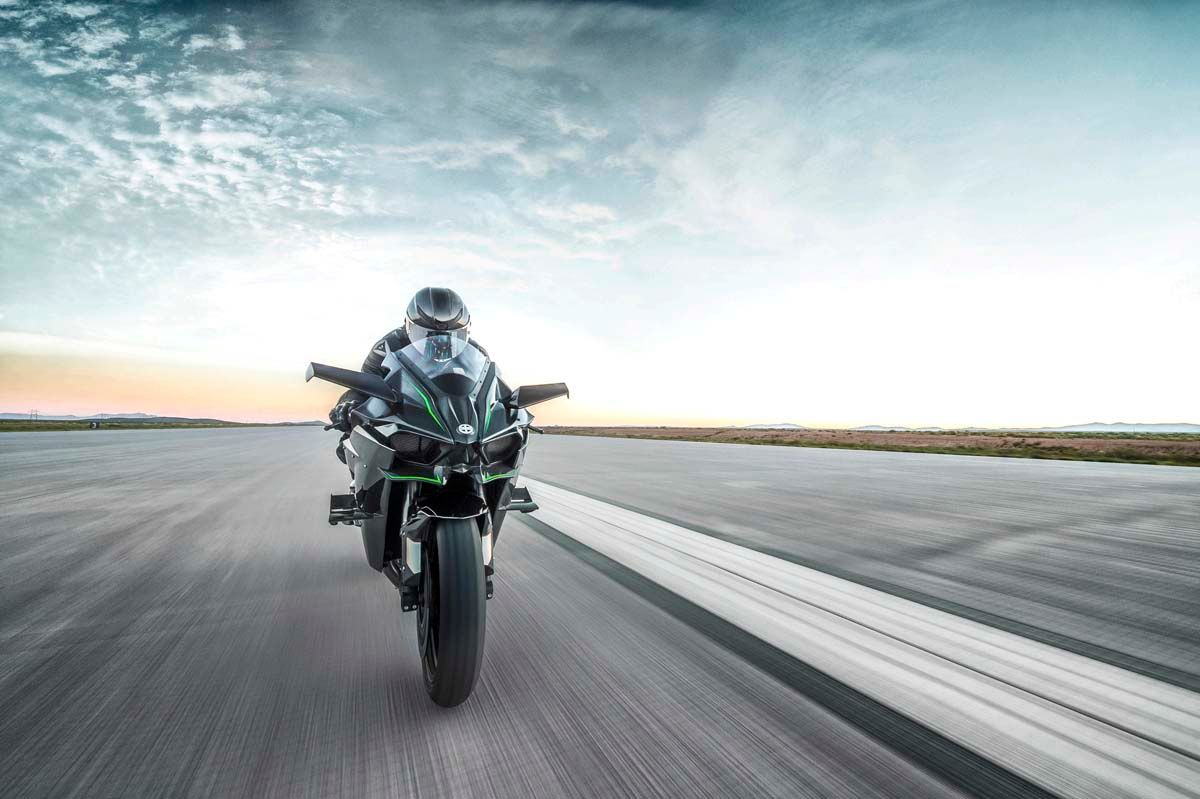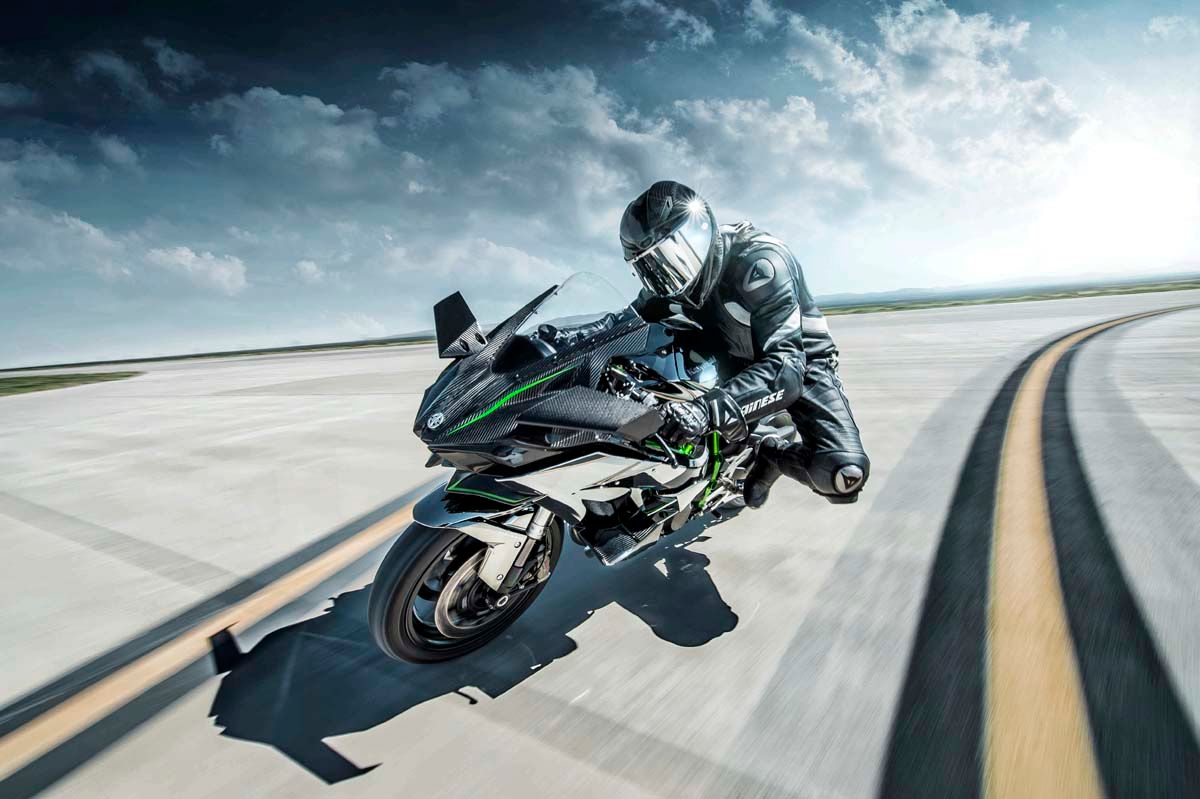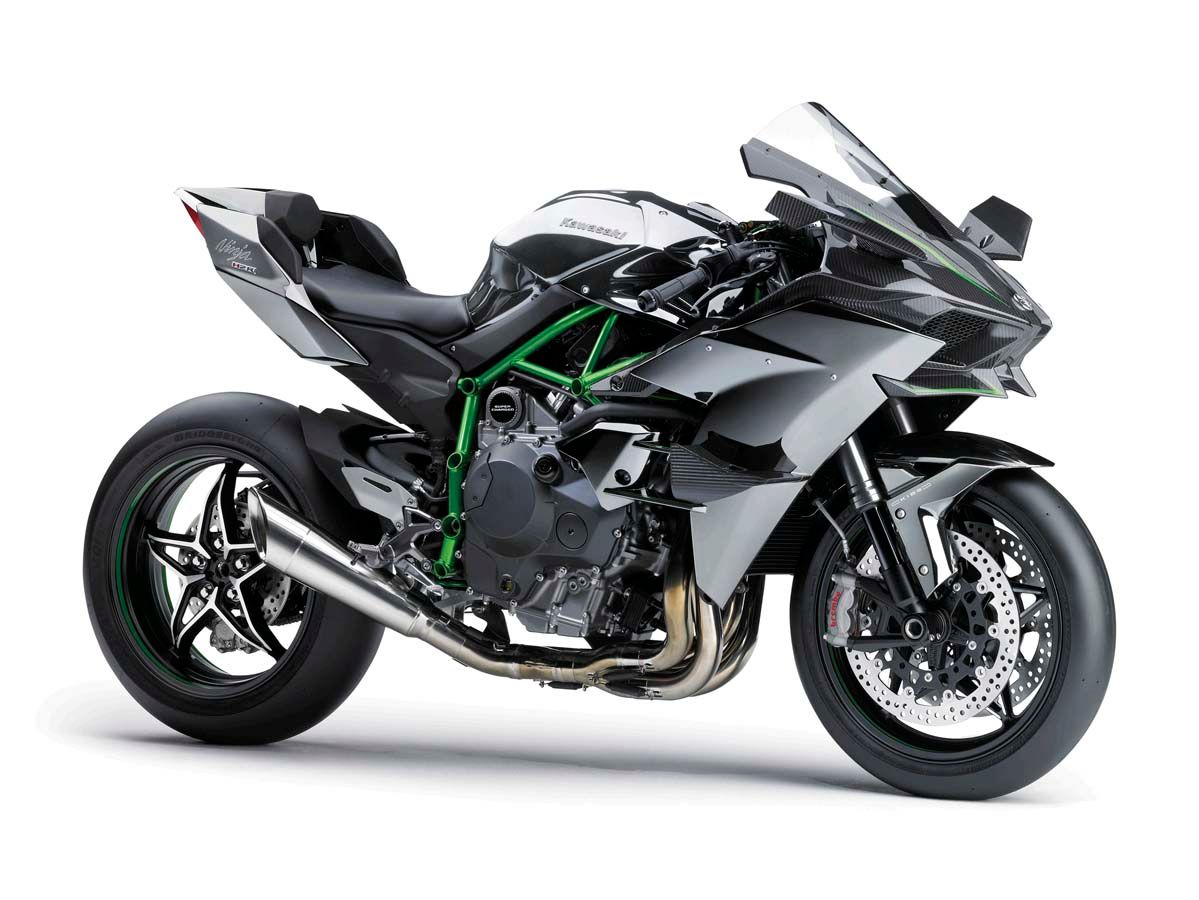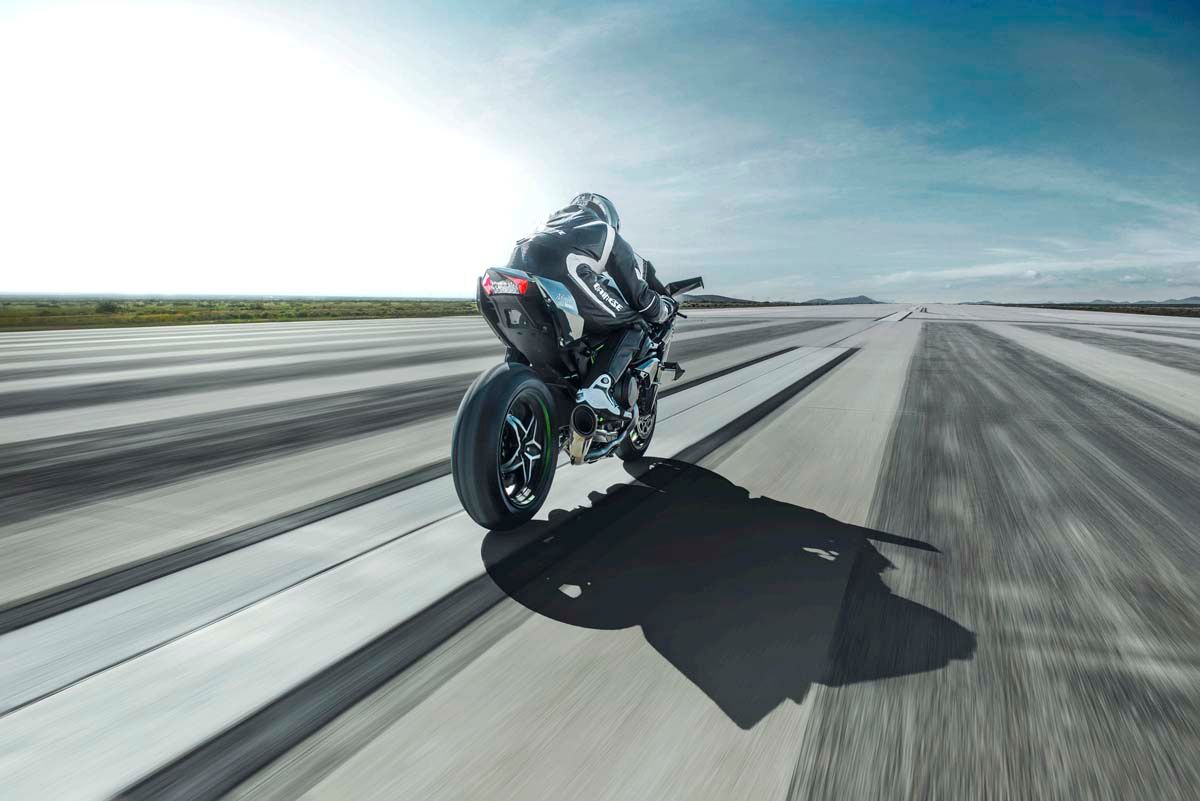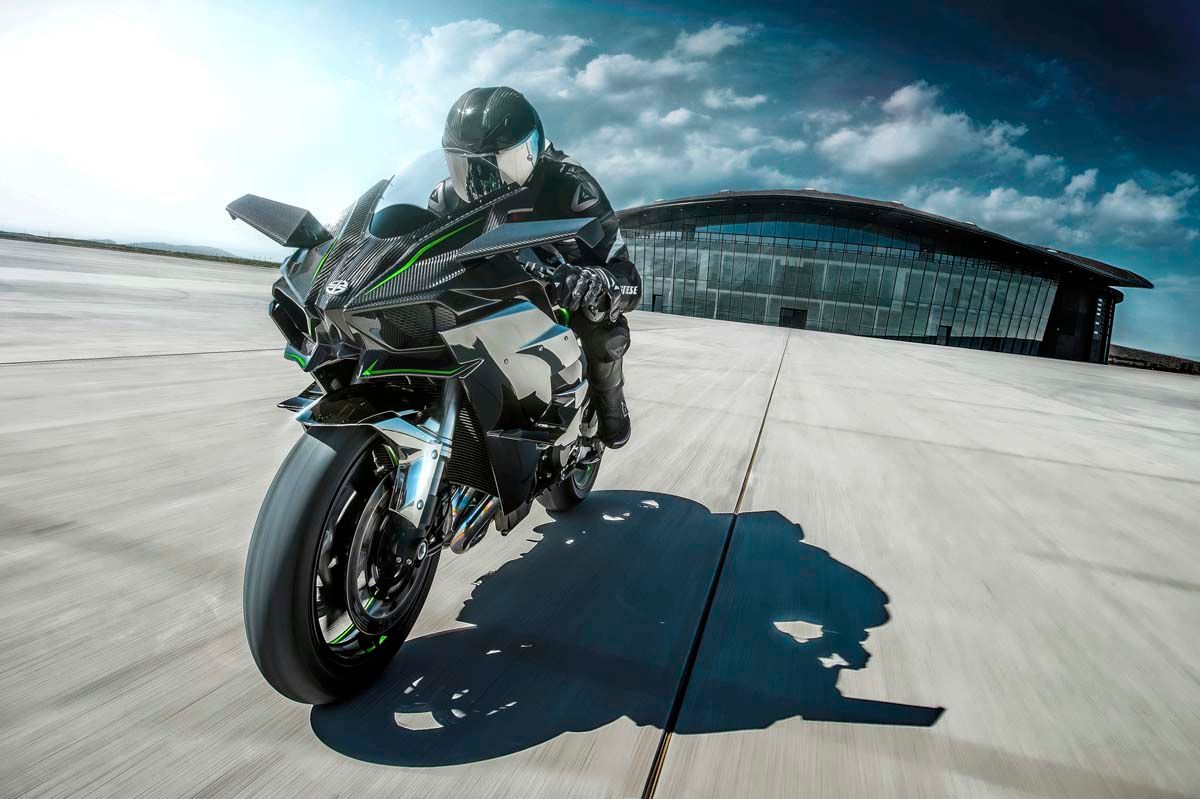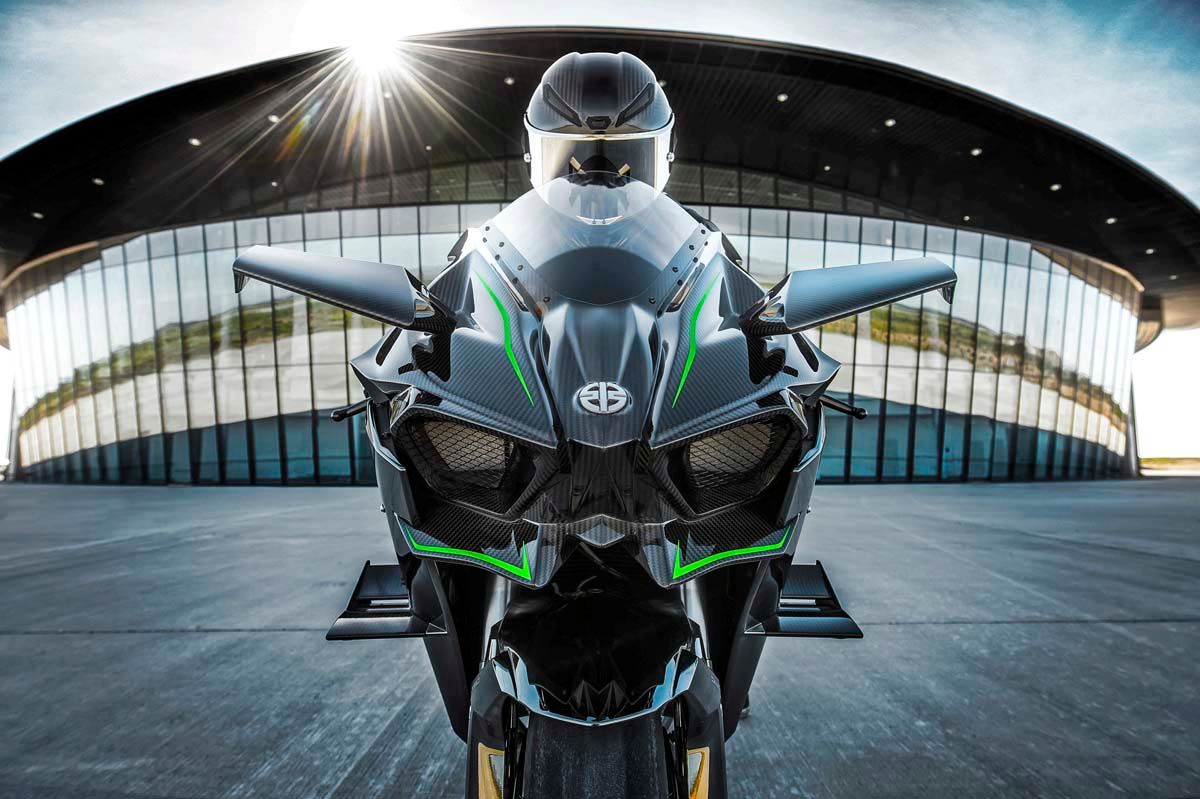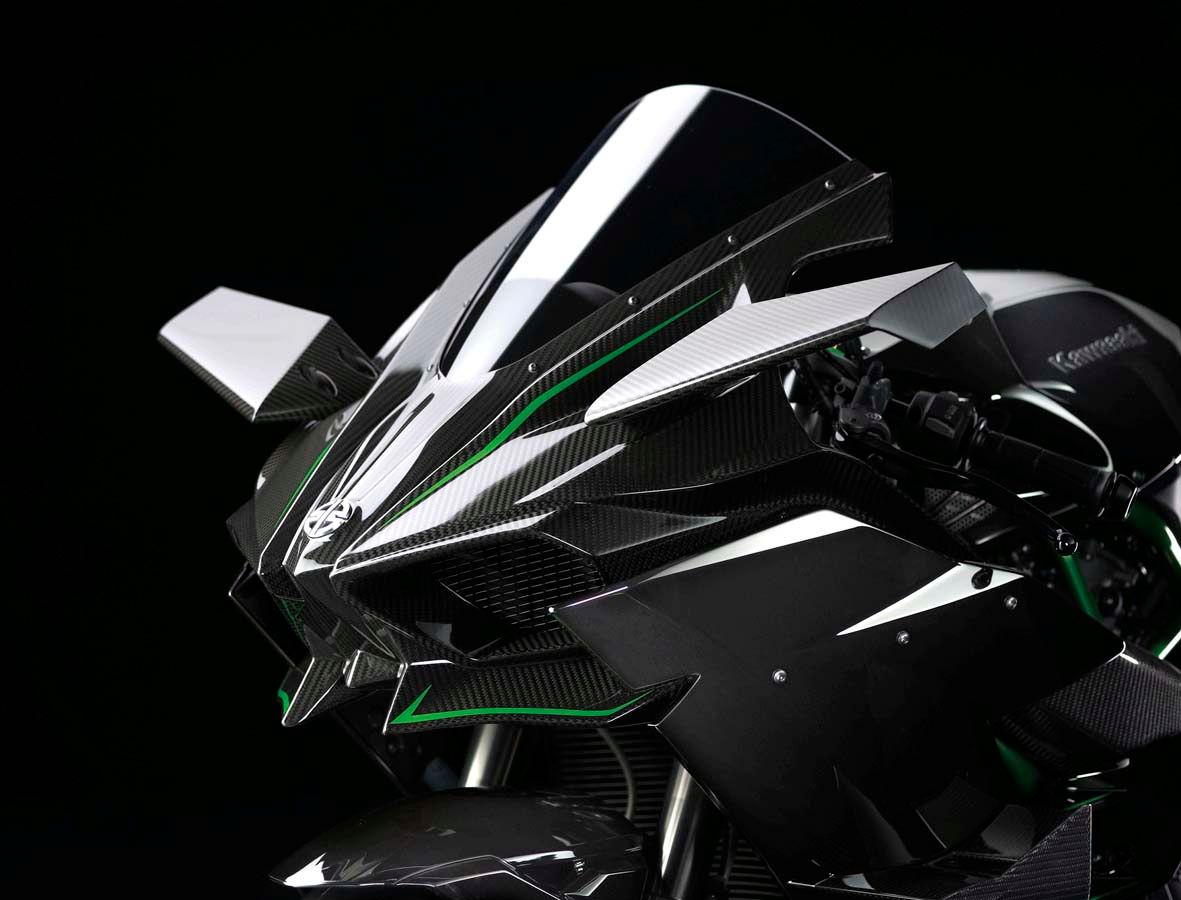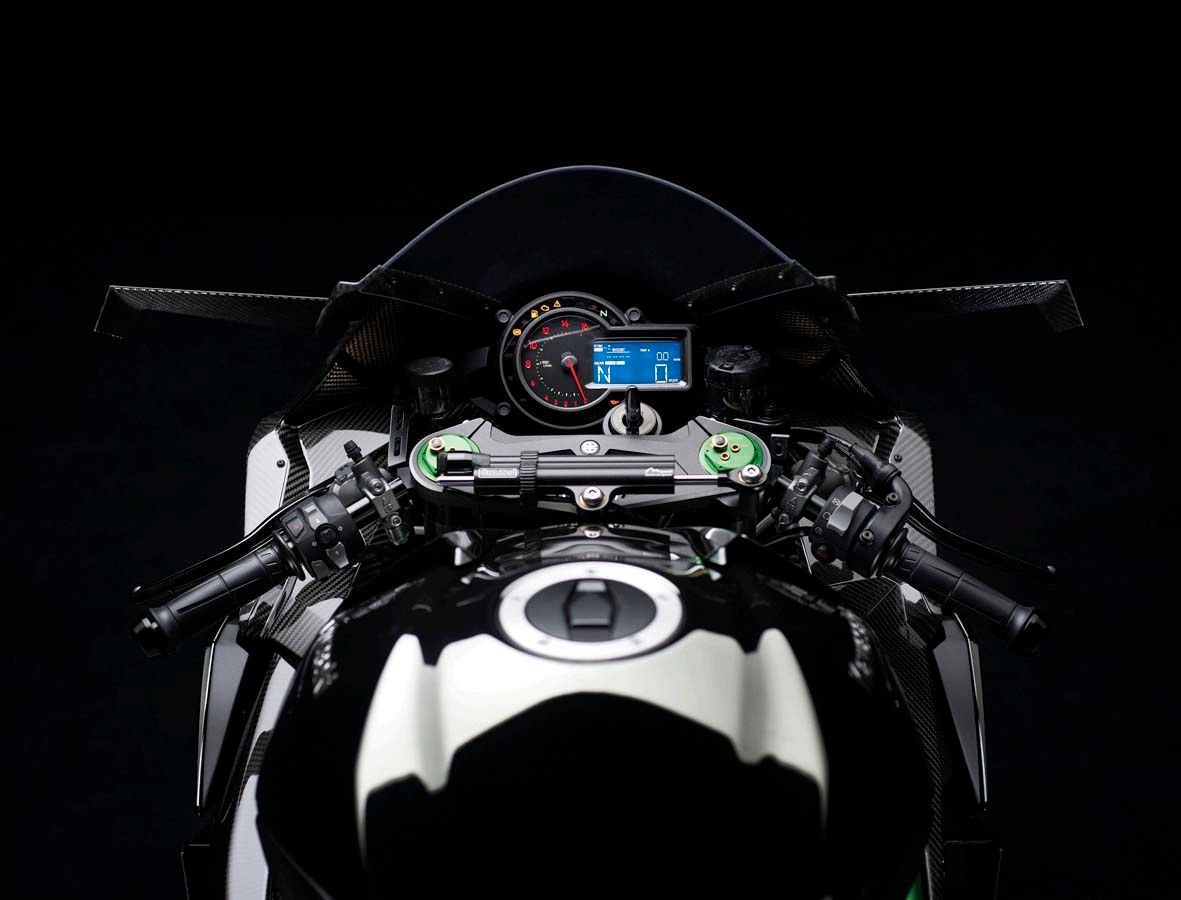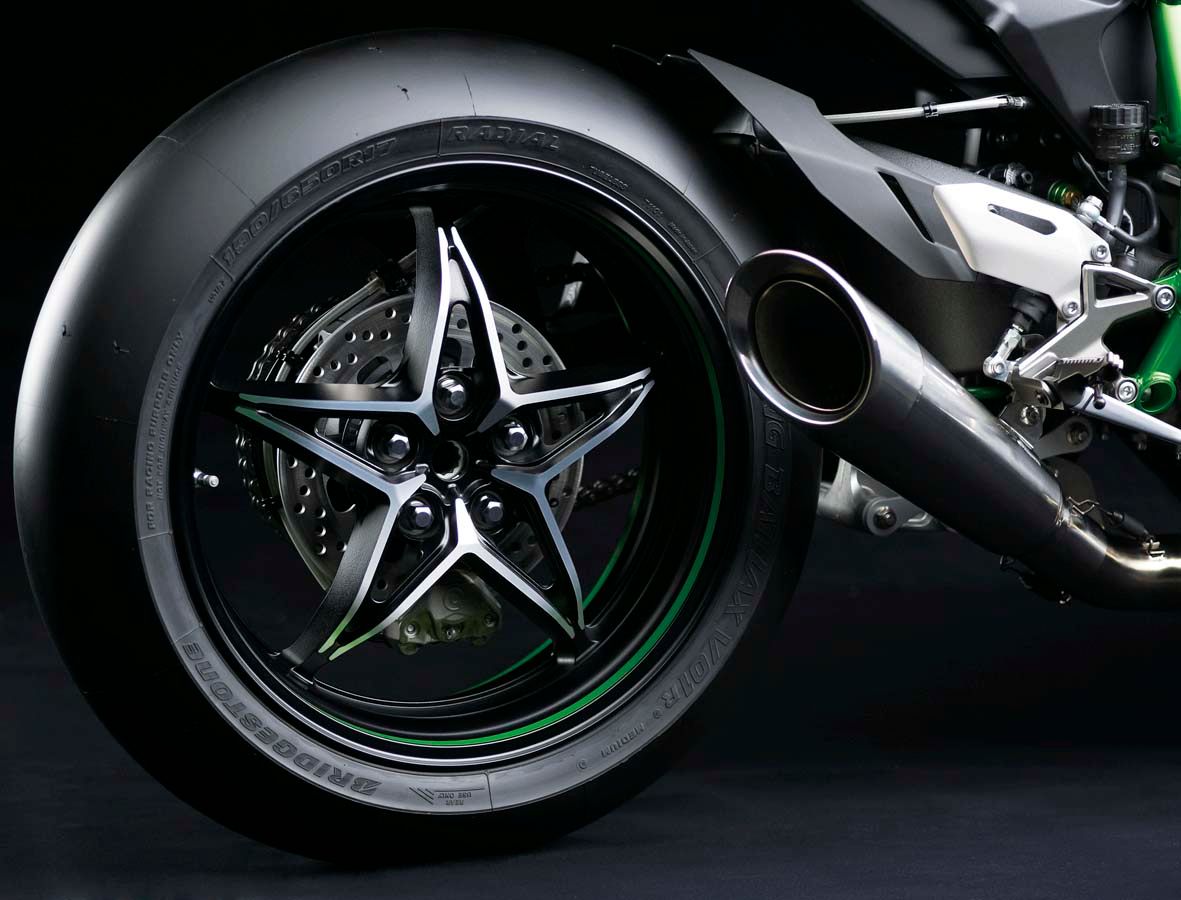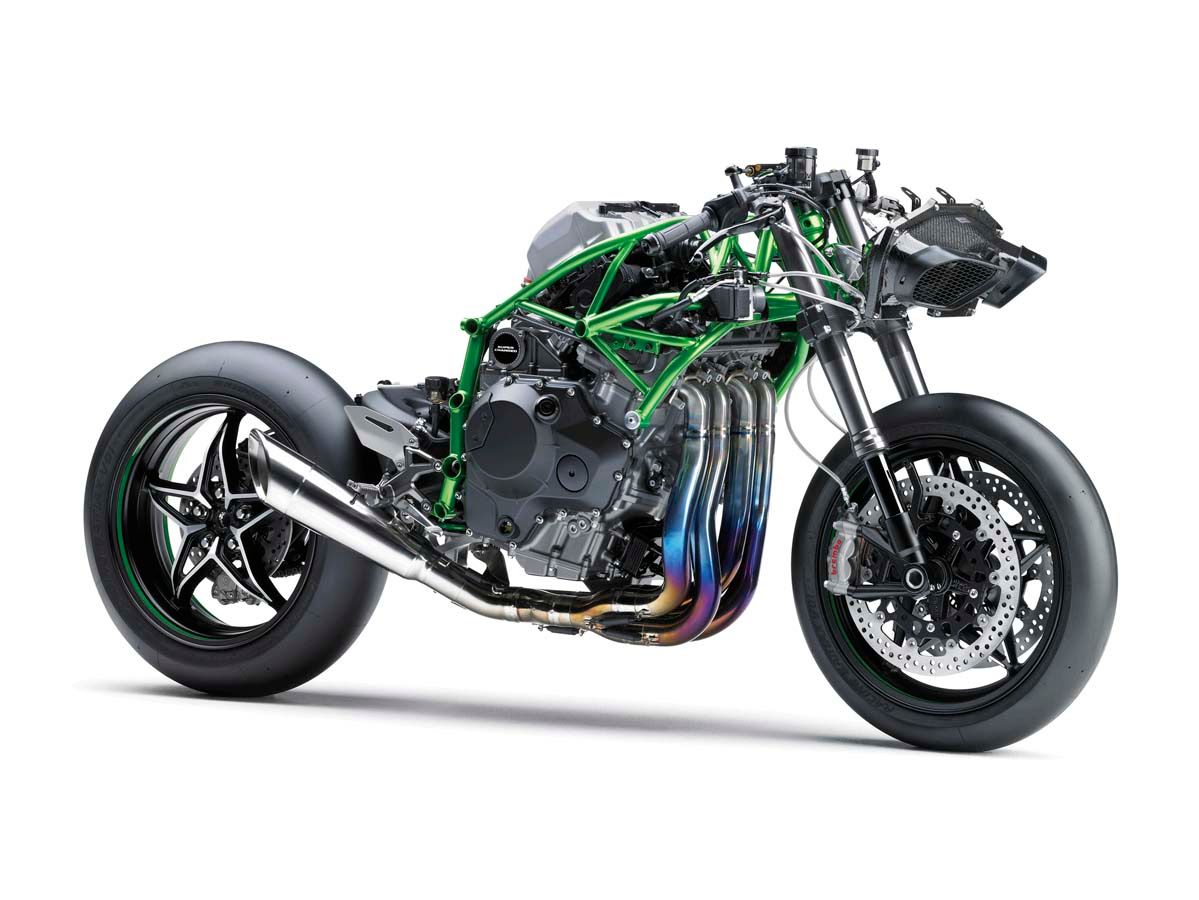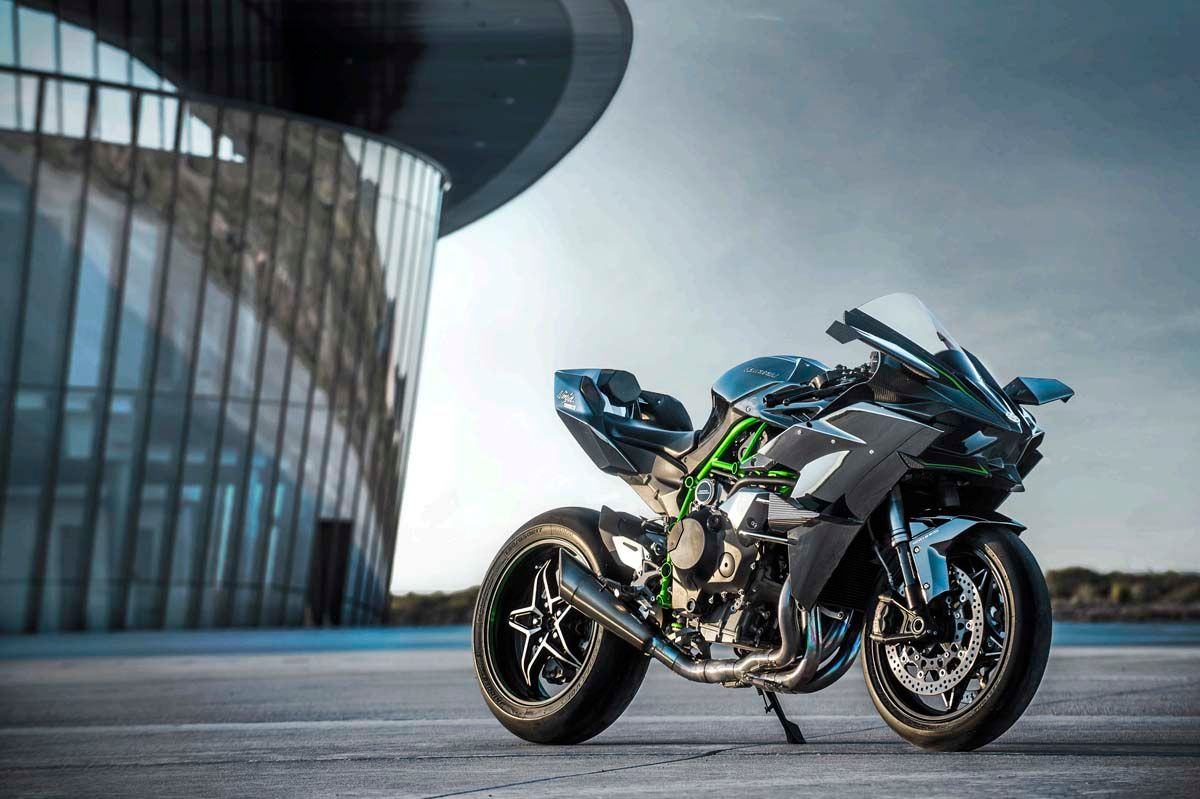2015 Kawasaki Ninja H2R
- Make: Array
- Model: 2015 Kawasaki Ninja H2R
- Engine/Motor: Liquid-cooled, 4-stroke in-line four
- Transmission: 6-speed
- [do not use] Vehicle Model: Array
Overview
Built Beyond Belief
The launching point for the development of the Ninja H2™R motorcycle was a strong desire to offer riders something they had never experienced before. Convinced that an extraordinary riding experience would not be found by merelybuilding on the performance of existing models, the design team committed to developing the “ultimate motorcycle” from a clean slate.
The bike needed to deliver intense acceleration and ultra-high top speed, coupled with supersport-level circuit performance. To realize this goal, help was enlisted from other companies within the Kawasaki Heavy Industries, Ltd. (KHI) group, precipitating an unprecedented level of collaboration.
Developing the Ninja H2R as a closed-course model allowed the unadulterated pursuit of performance, free from the limitations that street riding would impose. The result was a new model offering a sensory experience surpassing anything else that riders can find today. The Ninja H2R is powered by a supercharged engine with a compact design on par with powerplants found in liter-class supersport models. The key to achieving its incredible performance lies in the engine’s supercharger, which is a motorcycle-specific unit designed completely in-house with technology from Kawasaki’s Gas Turbine & Machinery Company, Aerospace Company and Corporate Technology Division.
2015 Kawasaki Ninja H2R Key Features:
• Ninja H2R is designed for closed-circuit use only
• 998cc four-cylinder engine fitted with Kawasaki supercharger for intense acceleration
• Supercharger uses planetary gears, spins at up to 130,000rpm and develops up to 20.5psi boost pressure
• MotoGP™-style dog-ring transmission allowsfast shifting and works with standard quick shifter
• Bodywork developed with Kawasaki Aerospace Company to generate downforce
• Kawasaki River Mark used to indicate combined Kawasaki Group technology
• Trellis frame used for first time on a Kawasaki motorcycle to provide strength, controlled flex and air circulation
• Single-sided swingarm used for first time and mounted to the engine
• KYB® AOS-II Air-Oil Separate cartridge fork, adjustable KYB rear shock
• 330mm front discs with four-piston Brembo® calipers
• Multi-mode traction control, launch control, engine braking control, ABS and a quick shifter
2015 Kawasaki Ninja H2R Features and Benefits:
Supercharged 998cc In-Line Four
The Quest For Power
In order to offer intense acceleration, it was essential that the engine was able to produce big power. While a large-displacement engine could easily provide high output, the engineers preferred it to be compact to help ensure a lightweight, compact motorcycle.
Using a supercharged engine enabled these engine design requirements to be met, and the immense potential of the compact, highly efficient engine is a testament to the technology developed by the KHI Group.
KHI-Designed Supercharger
The supercharger used by the Ninja H2R was designed by Kawasaki motorcycle engineers with assistance from other companies withinthe KHI Group, namely the Kawasaki Gas Turbine & Machinery Company, Aerospace Company, and Corporate Technology Division. Designing the supercharger completely in-houseallowed it to be developed to perfectly match the engine characteristics of the Ninja H2R. The highly efficient, motorcycle-specific supercharger was the key to achieving the maximum power and intense acceleration the engineers wanted.
• One of the greatest benefits of designing the supercharger in-house and tailoring its design to match the character of the Ninja H2R engine was that engineers were able to achieve high-efficiency over a wide range of conditions – something that would not have been possible by simply using an aftermarket automotive supercharger.
• The importance of high efficiency in a supercharger is that as air is compressed, power-robbing heat gain is minimal. And while many superchargers are able to offer high-efficiency operation in a limited range of conditions, the KHI-designed supercharger offers efficiency over a wide range of pressure ratios and flow rates. This translates into strong acceleration.
• The supercharger’s high efficiency and minimal heat gain meant an intercooler was unnecessary, allowing savings in both weight and space.
• The supercharger is a centrifugal-type unit – ideal for high-RPM performance – with a cast aluminium housing.
• The unit is located centrally, behind the cylinder bank, in the best position to evenly distribute compressed air toall four cylinders.
• The supercharger uses engine oil for lubrication. By not requiring an independent oil source, it contributed to the compact, lightweight design.
• The supercharger is driven by a planetary gear train, which runs off the crankshaft. Designing the gear train using technology from Kawasaki’s Aerospace Company resulted in a compact unit with minimal power loss.
• The gear train increases the impeller speedup to 9.2x the crank speed (1.15x step gear with an 8x planetary gear). Thismeans at a maximum engine speed of approximately 14,000rpm, the impeller shaft is spinning at almost 130,000rpm.
• The impeller is formed from a forged aluminium block using a 5-axis CNC machine to help ensure precision and durability. The 69mm impeller features six blades at the tip, expanding to 12 blades at the base. Grooves etched into the blade surfaces help direct the airflow.
• The impeller’s pumping capacity is more than 200 liters/second (measured at atmospheric pressure), with intake air reaching speeds of up to 100m/s. After passing through the supercharger, air pressure is increased to as much as 2.4x atmospheric pressure (35psi).
Power Unit Designed For High Performance
Despite its familiar in-line fourconfiguration, the Ninja H2R engine is loaded with technology developed specifically for this supercharged engine: some new, others with know-how from the Kawasaki Group.
Every component of the engine was chosen to achieve a certain function. In order to accommodate the higher air pressure from the supercharger, as well as to help ensure reliability, the entire engine was designed to be able to handle stresses 1.5-2x greater than a naturally aspirated liter-class engine.
• The combustion chamber design is complemented by flat piston crowns. The shape, inspired by the pistons used in the Green® Gas Engine developed by Kawasaki’s Gas Turbine & Machinery Company, also contributes to the engine’s anti-knock performance.
• While the intake valves are stainless steel, the exhaust valves needed to be able to withstand the supercharged engine’s high-temperature exhaust gases. So the exhaust valves are formed from two materials that are friction-welded at the center: Inconel – an extremely heat-resistant alloy – is used for the valve head and lower half of the stem; while heat-resistant steel is used for the upper half. The stems are tapered, varying in diameterfrom 4.5-5mm.
• A dummy head is used during the cylinder honing process. The more precise circular and cylindrical shape that results allows the use of low-tension piston rings, which help reduce mechanical loss.
Dog-Ring Transmission
To facilitate smooth, quick shifting, a dog-ring-type transmission was selected. This is similar
to the kind of transmission commonly found in MotoGP™ or Formula 1®, and was developed with the Kawasaki Racing Team.
• Unlike a standard motorcycle transmission, where the shift forks slide the gears into position, the gears remain in place in a dog-ring transmission. Only the dog rings move, sliding into position to engage the desired gear.
• Because the dog rings are lighter than transmission gears,this type of transmission offers a significantly lighter shift effort. Shift feel is also improved, and a much quicker shift is possible, facilitating quicker acceleration.
Hydraulic Clutch & Back-Torque Limiter
A high-quality hydraulic clutch offers less maintenance and helps to ensure that the initial bite point can be maintained. By using Brembo® components, superb linearity and smooth actuation are further benefits.
• Brembo parts are used for both the clutch lever’s radial-pump master cylinder and the clutch release mechanism. They receive extra attention from Brembo before being shipped to Kawasaki. Each part is examined and adjusted to help eliminate any ineffective (idle) stroke, resulting in superb control.
• The back-torque limiter contributes to stability by helping prevent wheel hop when downshifting. The back-torque limiter is also adjustable.
Maximizing Airflow Efficiency
To maximize the performance of the supercharged engine, airflow efficiency was of paramount importance. How air enters the supercharger, how the compressed air enters the engine, and how the combusted air/fuel mixture is discharged were all carefully analyzed for maximum efficiency to help ensure the airflow characteristics would create the desired engine character.
Ram Air Intake
• Air supplied to the supercharger enters via dual ram air intake in the upper cowl. The total frontal area is approximately 13,000mm² – illustrating how much air is needed to achieve such high horsepower.
• A ram air duct was designed to take the fresh air to the supercharger in the straightest line possible. Its shape was created to match the impeller characteristics, further contributing to the engine’s output.
• The duct is constructed from rigid, lightweight carbon fiber to help ensure the optimized shape is maintained when pressurized.
Aluminium Intake Chamber
• The intake chamber has a large volume (6liters), and is ideally shaped for high efficiency and engine output.
• Rigid aluminum construction offers two advantages:
1) Excellent surface heat dissipation, helping to keep the intake air cool;
2) Helps to ensure an airtight seal for the pressurized air atapproximately 2-bar
(29.4psi).
• Inside the intake chamber, newly developed Kawasaki technology contributes to the engine’s high performance. The top injectors spray fuel onto stainless steel mesh positioned over the intake funnels. Thishas an ordering effect, creating a more uniform air/fuel mixture as the fuel is drawn into the intake funnel. The mesh also promotes fuel misting, which helps coolthe intake air and increases combustion chamber efficiency.
Electronic Throttle Valves
Kawasaki’s fully electronic throttle actuation system enables the ECU to control the volume of fuel (via fuel injectors) and air (via throttle valves) delivered to the engine. Ideal fuel injection and throttle valve position results in smooth, natural engine responseand the ideal engine output. The system also makes a significant contribution to reduced emissions.
• The system enables more precise control of KTRC (Kawasaki TRaction Control), and facilitates implementation of other electronic systems like Kawasaki Launch Control Mode and Kawasaki Engine Braking Control.
Intake & Exhaust Ports, Camshaft Profiles
• The intake ports are polished to help ensure smooth air/fuel flow and minimize resistance.
• Straight exhaust ports – one for each exhaust valve – do not converge in the cylinder head. The straight-line design enables the most efficient removal of exhaust from the combustion chamber and also contributes to efficient combustion chamber filling.
• Designed for high performance, the camshaft profiles were optimized with high valve lift and wide overlap. The lift helps large volumes of air enter and exit the combustion chamber quickly, while the wide overlap is used to help expel the spent fuel-air mixture from the exhaust ports.
Exhaust System
• The entrance to the header pipes is oval to match the two exhaust ports per cylinder. Partly formed by hydroforming, each header pipe tapers from an oval to a round cross-section. The collector pipesare also hydroformed.
• The titanium exhaust system has a simpledesign. It consists of the header and collector pipes, a joint pipe as well as a straight-pipe, megaphone-style silencer.
Keeping The Engine Cool
Cooling performance can be a substantial limiting factor for engine output, so maximizing the cooling efficiency was a key consideration when designing the engine. In addition to helping ensure that intake air remain as cool aspossible, the heat generated by the high-output engine needs to be dissipated, and engine components themselves need to be kept cool to help ensure efficient operation. The extensive pursuit of cooling performance led to a highly complex engine layout, both for the lubrication system and the cooling system.
Cylinder Head
The design of the aluminum cylinder head provides the necessary cooling performance. The large coolant passageways result in excellent cooling for the combustion chamber.
• The water jacket extends between the twinexhaust ports of each cylinder, while large coolant passageways around the spark plug holes and valve seat areas offer superior cooling. The spark plugs and steel valve seats have a greater tendency to retain heat than the aluminum cylinder head, so cooling them is very important and makes a significant difference to temperature control.
Oil Jets
In the interest of keeping the engine compact and simple, a single lubrication system provides cooling oil for the engine components, supercharger and the transmission.
• Oil jets lubricate the supercharger chain atthe contact points where the chain meets the upper and lower sprockets.
• In addition to the two oil jets, the supercharger drivetrain’s lower gear has an oil passage.
• Inside the engine, there are two oil jetsper cylinder to ensure the pistons are effectively cooled.
• Transmission oil jets (used for the first time in a Kawasaki motorcycle) enable a compact transmission with high durability.
Lubrication System Components
Because the lubrication system is servicing so many components, oil volume is 5.0 liters (1.3 gallons) – that is about 35% more than usually seen in a naturally aspirated engine of the same displacement.
Radiator
• The radiator’s size and capacity is similar to those found on current liter-class supersport motorcycles, but it offers superior cooling performance because it flows approximately 1.5x more air than other bikes. This was found to be more effective than simply increasing the size of the radiator.
• Airflow is facilitated by the compact side-cowl design, and leaving the lower part of the engine open to the air (except for the small under cowls) was designed to extract hot air.
Liquid-Cooled Oil Cooler
• A liquid-cooled oil cooler adds to the extremely high cooling performance necessary for the high output engine.
High-Speed Stability & Light Handling
The objectives for the chassis were to provide superb motorcycle composure at ultra-high speeds, while offering cornering performance that allows the rider to enjoy circuit use, and finally to be very accommodating to the rider. Ordinarily, high-speed stability can easily be achieved with a long wheelbase, but a shorter wheelbase was selected to achieve the compact overall package and sharp handling that were desired. So the frame needed to not only be stiff, but also to be able to absorb external disturbances, which could otherwise unsettle the chassis when encountered at high speed. A trellis frame provided both the strength to harness the incredible power of the supercharged engine, and the balanced flex to achieve stability for high-speed riding.
Innovative Chassis Design
Trellis Frame
Using a trellis frame offered an elegant, lightweight solution to meeting the performance requirements for the chassis of the closed-course Ninja H2R. Able to harness the massive power of its engine, it has a balance of stiffness and flexibility that enables a high level of stability while being able to handle external disturbances at high speeds. Its open design also helps dissipate heat generated bythe supercharged engine.
• Development of the trellisframe made good use of the latest analysis technology and substantial test rider feedback.
• Pipe diameter, thickness and the bend of each piece of the trellis frame were carefully selected to obtain the necessary stiffness for each part of the frame.The trellis pieces are primarily made fromhigh-tensile steel.
Swingarm Mounting Plate
This innovative new chassis mechanism allows the engine to act as part of the frame.
• The swingarm mounting plate bolts to the back of the engine. The swingarm pivot shaft goes through this plate, essentially allowing the swingarm to be mounted directly to the engine.
• Thanks to the swingarm mounting plate, the frame does not need to use crossmembers for stability. This contributes to the frame’s low weight.
Single-Sided Swingarm
The Ninja H2R features Kawasaki’sfirst single-sided swingarm.
• Having a single-sided swingarm allows the exhaust pipe to be mounted closer to the bike’s centerline, providing a highbank angle for sporty cornering.
Chassis Geometry
To ensure fun at high speeds on the racing circuit, a compact package was desired.
Therefore, the chassis geometry isvery similar to that of a liter-class supersport motorcycle.
FRONT SUSPENSION KYB® AOS-II racing suspension makes its debut on this innovative machine.
• Based on the Air-Oil Separate cartridge fork that was developed for motocross racing.
• Designed for low friction, the 43mm front fork offers superb action, with a smooth initial action followed by strong damping at the end of the stroke.
• As the suspension works, a large 32mm free-floating piston at the bottom of the oil-damping cartridge pumps oil up to a sealed area between the inner and outer tubes. The oil in this area provides a friction-reducing film on which the tubes can slide against each other, resulting inan extremely smooth action.
Rear Suspension
Fully adjustable KYB rear suspension offers superb stability.
• The top of the rear shock mounts to the swingarm mounting plate, doing away with the need for frame crossmembers.
• The bottom of the rear shock is mounted via a revised Uni-Trak® linkage that offers excellent feedback for rear tire grip. The new linkage, situated below the swingarm, also mounts to the swingarm mounting plate.
Brakes
Given the high-speed potential of the Ninja H2R, the brakes chosen were the best available for a production motorcycle. Special tuning helped ensure that all play in the lever was removed from the system, so that the brakesrespond immediately when they are applied.
• A pair of massive 330mm Brembo semi-floating front discs, with a thickness of 5.5mm, delivers superb braking force.
• The brake discs have grooves running down the center of the outer edge to increase the discs’ surface area for greater heat dissipation.
• Dual radial-mount Brembo cast aluminum monobloc calipers grip the front discs. The rigid, opposed four-piston calipers with 30mm pistons contribute to the superb braking force of the Ninja H2R, as well as a high-quality image.
• A Brembo radial-pump master cylinder and reservoir receive extra attention before being shipped to Kawasaki. Each part is examined and adjusted tohelp eliminate any play in the lever stroke.
• A large 250mm disc generates strong braking force at the rear.
Original Wheel Design
The cast aluminum wheels were designed specifically for the Ninja H2R.
• The star-pattern five-spoke wheel design was selected based on the optimum balance of rigidity for high-speed performance.
• Knurling on the inside of the rear wheel rim helps prevent tire slipping on the wheel that could be caused by the massive torque generated by the engine.
• The analysis technology used in the wheeldevelopment comes from Kawasaki’s World Superbike involvement.
High-Speed Tires
To help ensure sufficient tire durability when riding at high speed, high-performance tires are used.
• The Ninja H2R is equipped with slick racing tires. The Bridgestone RACING BATTLAX V01 tires fitted are commercially available, superbike-style racing tires rated for ultra-high speed operation.
Shaped For Speed
As speed increases, wind resistance increases exponentially. To enable high-speed operation, a combination of high power and slippery aerodynamics was needed. With power requirements taken care of by the supercharged engine, the next step was to design bodywork that provides both minimal drag and good control when riding at high speed. Assistance from Kawasaki’s Aerospace Company was enlisted in creating the aerodynamically sculpted bodywork to provide maximum aerodynamic efficiency.
Aerodynamics
Aerodynamically Designed Bodywork
It is no accident that when viewed from the side, the Ninja H2R does not have the aggressive forward-canted rake of most modern supersport motorcycles. While supersport bikes use their front-leaning attitude to aid quick steering,at the speeds for which the closed-course Ninja H2R was designed, such a posture would create drag, which would hinder top speed potential. Therefore, the motorcycle’s stance is very neutral, almost flat to make the body as aerodynamically sleek as possible.
• The aerodynamically shaped upper cowl uses lips and lines to direct airflow over its surface.
• The upper cowl locates the ram air intakein the most efficient position.
• The cowl is formed from lightweight carbon fiber and is designed to afford wind protection at ultra-high speed, with its tall screen designed to help create a wind-free pocket for the rider.
• Compact side cowls and under cowls weredesigned to assist with engine heat dissipation.
• The rear cowl has an extremely compact three-piece design. The center portion is taller, creating an aerodynamic form that helps smooth airflow as it passes the rider. Wind is also able to pass between the center and side pieces, further reducing air resistance.
Generating Downforce
In order to maintain both straight-line stability and the ability to change direction while running at high speed, the Ninja H2R features a number of aerodynamic devices to help ensure the front wheel has strong contact with the ground.
• The design of the upper cowl incorporates a chin spoiler. Rather than being a cosmetic flourish, it produces downforce that contributes to high-speed stability.
• Further contributing to high-speed stability, the Ninja H2R features carbon fiber wings mounted on the upper cowl in place of mirrors. Designed by Kawasaki’s Aerospace company, they feature winglets to help smooth airflow near the wingtip. This is achieved by reducing the strength of the wingtip vortices that would otherwise cause turbulence or disturb the laminar flow needed for the wings to effectively generate downforce.
• Additional two-blade wings also appear on the side cowls. They again feature winglets and further add to the downforce generated by the chin spoiler and upper wings.
Seating For One
Riding Position & Ergonomics
The kind of riding the Ninja H2R was designed for, and a desire for a compact package resulted in a riding position similar to that of a supersport bike without being quite as aggressive. As enjoyment of the intense acceleration and high-speed capability was the first priority, a solo seat for the rideris the only seating provided.
• The riding position was designed for high speed and circuit riding. The rider triangle is similar to that of the Ninja® ZX™-10R motorcycle, but more relaxed.
• To help support the rider during intense acceleration, hip-supporting pads flank the rear of the seat. The hip support is adjustable 15mm backward with tools, to suit the rider’s size.
Instrumentation & Controls
The advanced, high-tech design ofthe instrumentation conveys the image of piloting a fighter jet. Handlebar control switches put all mode selection and display options at the rider’s fingertips.
• The new instrumentation design combinesa full digital LCD screen with an analog-style tachometer.
• The LCD screen uses a black / white reverse display (white characters on a black background), contributing tothe high-quality image.
• In addition to the digital speedometer and gearposition indicator, display functions include: odometer, dual trip meters, current mileage, average mileage, fuel consumption, coolant temperature, boost indicator, boost (intake air chamber) temperature, stopwatch (lap timer), clock and the Economical Riding Indicator.
• The tachometer design uses an actual needle,but the black dial “face” looks blank until engine speed increases. Backlit RPM numbers light up to chase the tachometer needle as it moves around the dial.
• Compact new handlebar switch design allows all instrument functions to be controlled from the handlebar.
Electronic Rider Support
Complementing the Ninja H2R’s incredible engine and chassis performance, advanced electronics work behind the scenes to provide rider support. Depending on rider preference, many of the systems may be turned off. And while the high-performance engine was designed to be accommodating even without the benefit of rider aids, when electing to fully experience the Ninja H2R’s intense acceleration or high-speed potential, these systems are available to provide an extra degree of rider confidence.
Engine & Chassis Management Systems
KTRC (Kawasaki Traction Control)
The new KTRC system used on the Ninja H2R combines the best elements of Kawasaki’s earlier traction control systems. Multi-level modes offer riders a greater number of settings to choose from, with each mode providing a different level of intrusion to suit riding conditions and rider preference. And all modes are designed to manage output when sudden wheel slip occurs. The new system offers both enhanced sport riding performance and the peace of mind to negotiate slippery surfaces with confidence.
• Riders can choose from three modes, each offering a progressively greater level of intrusion. Each of these modes also has three rider-selectable levels, adding more or less intrusion (rider preferences for each mode are programmable for on-the-move selection), giving a total of nine possible settings. Riders may also elect to turn the system off.
• Mode 1 and 2 are tailored for the circuit riding, while Mode 3 was optimized for more slippery conditions.
• Using complex analysis, the system is able to predict when traction conditions are about to become unfavorable. By acting before slippage exceeds the range for optimum traction, it means that drops inpower can be minimized, resulting in smoother operation.
Kawasaki Launch Control Mode
Designed to assist the rider by optimizing acceleration from a stop, Launch Mode electronically controls engine output to prevent wheelspin and minimize wheelies when launching.
• Riders can choose from three modes, each offering a progressively greater level of intrusion. Each mode allows the rider to launch from a stop with the throttle held wide open.
Kawasaki Engine Brake Control
The system allows riders to select the amount of engine braking they prefer.
• When the system is activated (by selecting “LIGHT” in the Engine Braking settings), the engine braking effect is reduced, providing less interference when riding on the circuit.
KIBS (Kawasaki Intelligent Anti-Lock Brake System)
Kawasaki’s supersport-style ABS is standard equipment on the Ninja H2R. This is based on the same system used on the Ninja ZX-10R, with programming and settings revised to suit the performance parameters of the Ninja H2R.
• High-precision brake pressure control enables the system to avoid reduced brake performance due to excessive pressure drops, allows lever feel to be maintained when KIBS is active, and helps ensure ABS pulses feel smooth (not heavy).
• High-precision brake pressure control also offers a number of sport riding benefits:
1. Rear lift suppression
2. Minimal kickback during operation
3. Accounts for back-torque
• Riders have the option to deactivate the system.
• There are three possible settings:
ON – KIBS affects both front and rear brakes
R OFF – KIBS affects only the front brakes
OFF – KIBS is deactivated
KQS (Kawasaki Quick Shifter)
Ninja H2R is the first Kawasaki motorcycle to be fitted with a standard quick shifter.
• Complementing the engine’s strong power and the dog-ring transmission, a contactless-type quick shifter enables rapid upshifts for seamless acceleration.
Öhlins Electronic Steering Damper
Unlike a mechanical steering damper – in which the settings, once fixed, must cover all riding conditions and speeds – the damping characteristics are changed electronically, according to vehicle speed and the degree of acceleration or deceleration. At low speeds, the settings were chosen so that damping does not interfere with the bike’s intrinsic lightweight handling. At high speeds, damping increases to provide enhanced stability.
• Kawasaki’s electronic steering damper was developed with Öhlins, one of the most popular and respected steering damper manufacturers.
• The electronic steering damper provides just the right amount of damping based on what the bike is doing. Using input from the rear wheel speed sensor (provided via the engine ECU), the electronic steering damper’sECU determines the vehicle speed as well as the degree the bike is accelerating or decelerating.
Styling & Craftsmanship
Wanting to ensure a bold design worthy of a model that carries both the “Ninja” and “H2” names, the prime styling concept for the Ninja H2R was “Intense Force” design. As a flagship for the Kawasaki brand, it needs to have presence, and styling that reflects its incredible performance. But the design is much more than cosmetic. While its edged styling certainly looks the part, the Ninja H2R also possesses a functional beauty: each piece of its bodywork was aerodynamically sculpted to enhance high-speed stability; the cowling design also maximizes cooling performance and heat dissipation, aiding the engine’s incredible output; and the ram air duct is ideally positioned to bring air to the supercharger. More than any Kawasaki motorcycle to date, the Ninja H2R is a showcase of craftsmanship, build quality and superb fit and finish – right down to the high-tech mirror-like paint specially developed for this model.
Intense Force Design
Styling & Craftsmanship Details
• Machined surfaces on the wheel spokes and painted rims contribute to a high-quality finish.
• High-level attention to detail is evident in the numerous machined fastener designs (such as the steering stem and rear hub nuts).
• High-quality materials are used throughout. For example, the inner cowl surrounding the instrument cluster is made from carbon fiber.
• The elegant LED tail light design (required by some circuits) contributes to the aggressive appearance of the rear.
• Welding bead quality for the trellis frame is uniformly high,contributing to the Ninja H2R’s superb fit and finish. Depending on the weld, some are efficiently and precisely welded by Kawasaki robots, while others are welded by expert Kawasaki craftsmen.
High-Tech Paint
The Kawasaki original silver mirror-like paint used on the Ninja H2R – known as mirror coated black – was developed by Kawasaki specifically for motorcycles. The highly reflective surface adds to the bike’s stunning design.
• In the shade, the paint appears black, but once in the sunlight its highly reflective surface takes on the appearance of the surrounding scenery. The stark difference in the way the paint appears in the light and shade emphasizes the beautiful curvature of the bike’s sculpted bodywork.
• The highly reflective surface is created byinducing a silver mirror-like reaction (a chemical reaction between a solution of silver ions and a reducing agent) that forms a layer of silver. This silver layer is whatcreates the paint’s glass-like metal appearance. Compared to candy paints, which use aluminum flakes to generate a sparkling effect, the silver layer appears as a uniform metallic surface.
• In the shade the silver layer is translucent, allowing the base coat color to show through. This gives the paint a deep, three-dimensional quality.
• While the multiple layers of paint on typical production vehicles are applied by robot painters, each layer of the paint on the Ninja H2R – from primer to clearcoat – is carefully finished by hand by Kawasaki craftsmen to ensure a flawless, lustrous surface. Twice the usual layers of clearcoat (two on standard pieces, four on pieces with decals) adds to the high-quality finish.
• The paint on the fuel tank is finished with a UV coat (the only layer where robot painters are used) to protect the tank’s brilliant finish.
Kawasaki River Mark
Special permission was obtained to use the River Mark on the NinjaH2R. Its use is reserved for models of historical significance.
High-Precision Production
Unlike a regular mass-production model, the high-precision production of the Ninja H2R requires greater hands-on participation by skilled Kawasaki craftsmen. So each step, from metalworking, treatment, welding and painting to assembly, fine-tuning and inspection is carefully attended to create a product of superior quality. Within Kawasaki’s Akashi Factory in Japan, production takes place in an area dedicated exclusively to the Ninja H2R motorcycle.
Color
The Kawasaki Ninja H2R is only available in its very special mirror coated black paint with the remaining bodywork in carbon fiber.
Ordering Information
The Kawasaki Ninja H2R is a limited-release production motorcycle, available for a short time in select markets. In order to reserve one of the world’s first supercharged production motorcycles, make a deposit at your local authorized Kawasaki dealer no later than December 19, 2014. Reservations will be taken on a first-come, first-served basis and are secured only with a deposit.
Specifications
|
Engine |
Liquid-cooled, 4-stroke in-line four |
|
Displacement |
998cc |
|
Bore x Stroke |
76.0 x 55.0mm |
|
Compression ratio |
8.3:1 |
|
Fuel System |
DFI® 50mm throttle bodies x 4 with dual injection |
|
Intake System |
Kawasaki supercharger |
|
Ignition |
Digital |
|
Transmission |
6-speed, return, dog-ring |
|
Final Drive |
Chain |
|
Front Suspension / Wheel Travel |
43mm inverted fork with rebound and compression damping, spring preload adjustability and top-out springs / 4.7 in |
|
Rear Suspension / Wheel Travel |
NEW Uni-Trak® with gas-charged shock, piggyback reservoir, dual-range (high/low speed) compression damping, rebound damping and preload adjustability, and top-out spring / 5.3 in |
|
Front Tire |
120/70 ZR17 M/C (58W) |
|
Rear Tire |
190/65 ZR17 M/C (78W) |
|
Front Brakes |
Dual radial-mount, opposed 4-piston calipers, dual semi-floating 330mm discs, KIBS ABS |
|
Rear Brakes |
Opposed 2-piston calipers, single 250mm disc, KIBS ABS |
|
Cooling System |
Water-cooled |
|
Frame Type |
Trellis, high-tensile steel, with swingarm mounting plate |
|
Rake/Trail |
25.1 degrees / 4.3 in |
|
Overall Length |
81.5 in |
|
Overall Width |
30.3 in |
|
Overall Height |
45.7 in |
|
Ground Clearance |
5.1 in |
|
Seat Height |
32.7 in |
|
Lubrication |
Forced lubrication, wet sump with oil cooler |
|
Curb Weight |
476.3 lb |
|
Fuel Capacity |
4.5 gal |
|
Wheelbase |
57.1 in |
|
Color Choices |
Mirror Coated Black/Real Carbon |
|
Price |
$50,000 |
Quotes
“In case you hadn’t noticed, online reservations are already being taken for the $50,000 Kawasaki Ninja H2R—the 300-hp track-only bike that’s “available for a short time in select markets.” Interestingly, Kawasaki has posted a list of online guidelines for potential H2R buyers to acknowledge before they plop down their big financial deposits to secure their orders. Why is such a list needed? Well, we think it relates directly to the otherworldly performance potential of the H2R, which is precisely what makes this list interesting and worthy to share. Without further ado, here’s the list of acknowledgements for the new 2015 H2R, exactly as it appears on Kawasaki’s consumer website.” ----- Cycle World“After a month-long teaser campaign hyping its forthcoming H2, Kawasaki finally revealed its new Ninja at the Intermot show. And does it live up to the hype? Well, the supercharged Kawasaki H2R claims 300 horsepower. The H2 takes its name from the 750cc two-stroke Triple Kawasaki produced in the early ‘70s, a bike that ushered in a new era of engine performance in production bikes. This latest iteration appears set to do the same with its 998cc Inline Four. Team Green heralds the H2R as “flagship for the Kawasaki brand,” which highlights technology developments from several divisions within the Kawasaki Heavy Industries (KHI) conglomerate.” ----- Motorcycle USA


